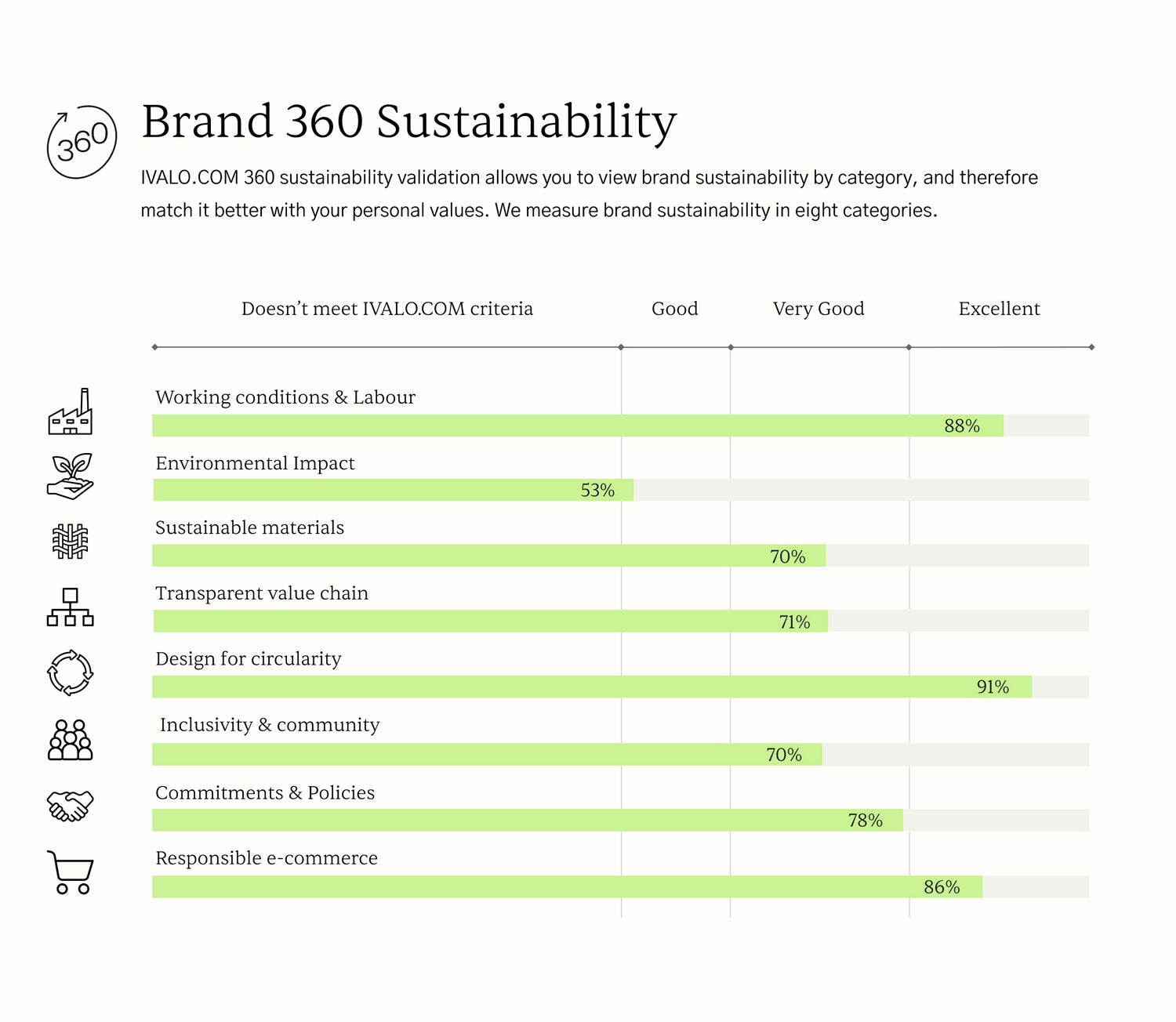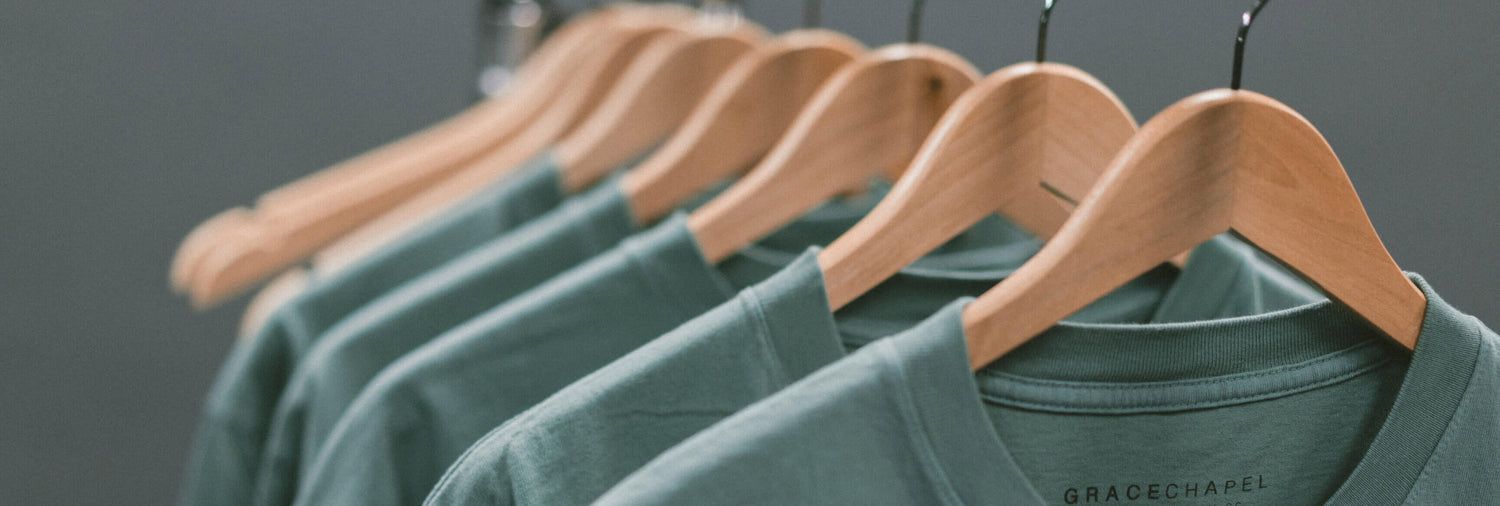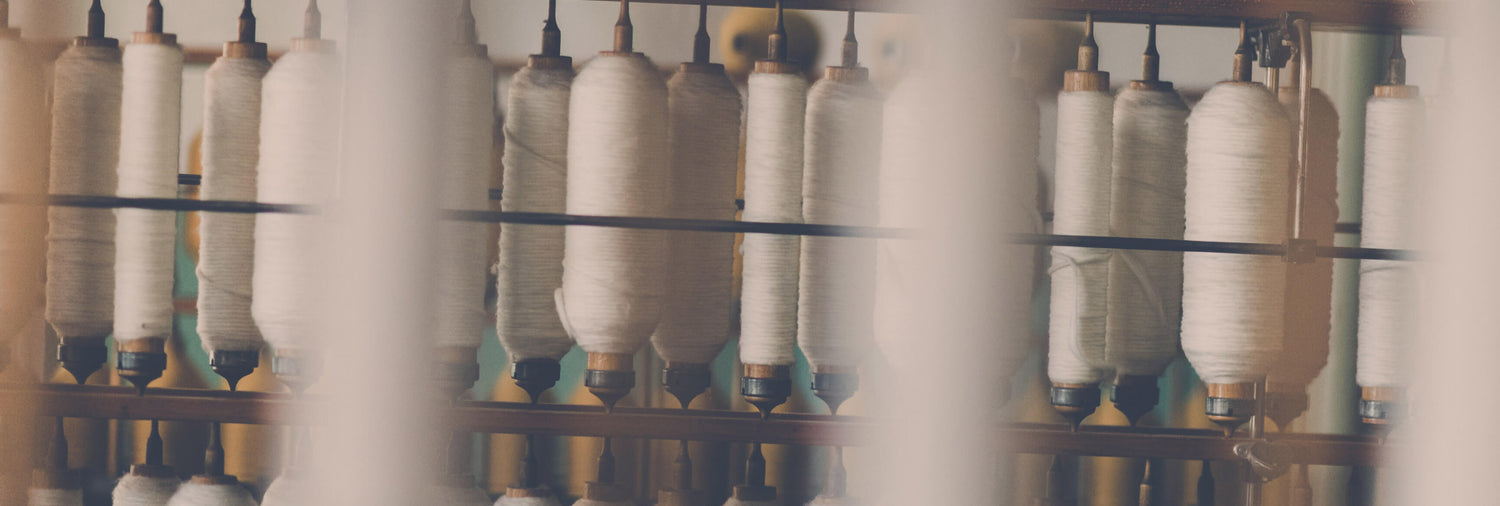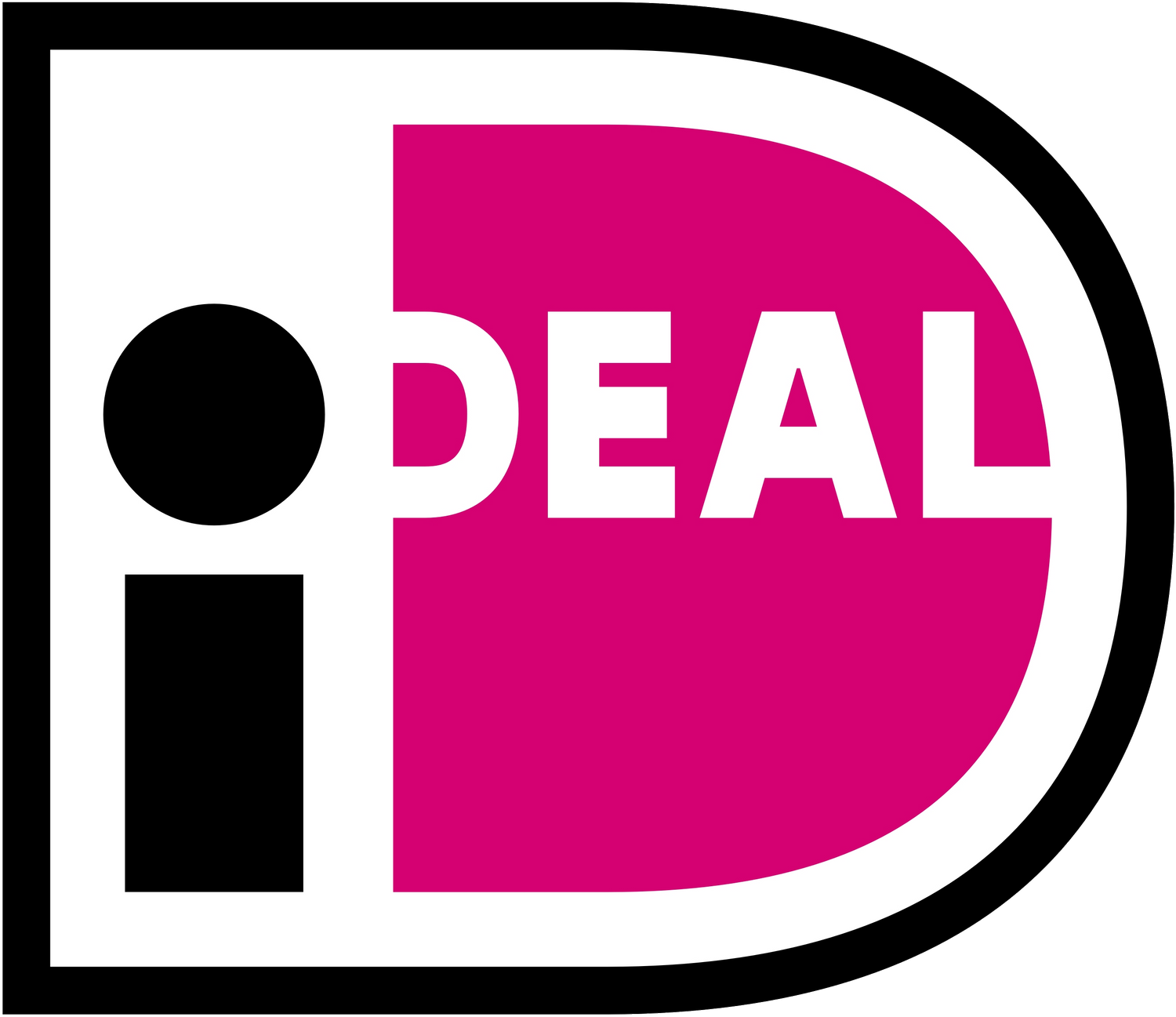
IVALO.COM 360
SUSTAINABILITY VALIDATION
Humanity is living through a time of dramatic changes. Climate change. Digitalisation. Nature cover and biodiversity collapse. The imperative to curb overconsumption. Circular economy. It is necessary and urgent for each of us to respond to systemic changes. One way is to vote with your money - with your everyday choices.
Sustainable values live in the small moments of our every day, in every cup of coffee, in our daily commute and in each piece of clothing in our wardrobes. Our decisions and choices have great power as a key to change and a more functional/different future.

What?
Despite good intentions, it is sometimes difficult for people to be aware of the ethical or environmental impact of their daily choices. It is not easy to distinguish genuinely responsible companies and products from greenwashing.
IVALO.COM 360 is an evaluation process developed by professionals that provide both fashion brands and customers buying clothes with a reliable view of brand sustainability.
The 360 validation gives brands an overall look of their own responsibility while helping customers to find clothing that fits their values.
IVALO.COM 360 sustainability validation will help you find products and brands that match your values.

Why?
Cheap and disposable clothing, an exploitative and polluting garment industry, massive overproduction and textile waste have come to an end.
Many of us have the interest and opportunity to make value-based choices. IVALO.COM's 360 validation tells the customer which aspects of sustainability different brands emphasise in their operations and production.
We are sincerely committed to a more sustainable future and want to help, guide and inspire.
We provide fashion brands with resources and tools for professional sustainability assessment. For customers in need of clothing and accessories, we bring the credit brands that have passed the assessment to one platform - IVALO.COM.
IVALO.COM wants to make responsible dressing a new everyday reality. People shopping for clothes can be confident that every brand validated on the marketplace is a safe choice.
The 360 validation gives brands an overall look of their own responsibility while helping customers to find clothing that fits their values.
5 Steps to the shop

Working Conditions & Labour
Areas of interest in this category:
- Safe working environment
- Decent working hours
- Living wage commitments
- This focus area counts for 20% of the total result points
Our brand partners have certified production that covers the working conditions in assembly of products.
Working conditions and labour rights refer to the conditions under which workers are employed in the factories, including their wages, working hours, safety, and health. Labour rights involve the legal and ethical protections of workers' rights, including the right to form unions and collective bargaining.
All our brand partners have committed to safe working environments. Some of our brands have certificates to guarantee audited production and safe working conditions. However, not all of these certificates, like GOTS or BSCI for example, do currently cover living wages. Only the working conditions.
Living wages provide workers with the basics of living. It allows them to meet their basic needs, including food, housing, healthcare, education, and other essential expenses. When workers earn a living wage, they are less likely to fall into poverty.
We acknowledge that paying living wages throughout the entire supply chain is very challenging in the textile industry from assembly to materials and fabrics production, all the way to the yarn, fibre manufacturing and fields. Therefore living wages are not a minimum requirement in our validation process. But most of our brand partners have product assembly facilities covered (Tier 1) as many of them have production in the EU.

Environmental Impact
Areas of interest in this category:
- Energy use
- CO2 emissions & compensations
- Water footprint, wastewater management
- Chemical use in production
- This focus area counts for 19% of the total result points
Logistics counts for only 3% of the fashion industry´s emissions. It is estimated that more than 70% of the emissions come from raw material production.
As the need to address climate change and ecosystem collapse become more urgent, all companies should be working to reduce their ecological footprints. Sustainable production minimises environmental impacts by reducing pollution and conserving natural resources and biodiversity.
Our brands have committed to sustainable production and seek to minimise greenhouse gas emissions, water pollution and depletion of natural resources.
To reduce the CO2 impact of textile production, they have also adopted a variety of environmental practices such as using mostly certified or recycled materials or other sustainable/preferred fibres, using renewable energy sources, avoiding overproduction and reducing waste. None of the brands are perfect at this, but they are doing a good job.
The heavy use of chemicals in the textile industry has also a significant environmental impact on local communities including water pollution, soil degradation, and human health risks. Harsh chemicals are used in various stages of textile production, such as fibre production, dyeing, and finishing, and can enter the environment through wastewater discharge or improper disposal.
None of our brands are using hazardous chemicals in their production and are committed to safe working environments for the workers.

Sustainable Materials
Areas of interest in this category:
- Sustainable materials
- Production chemicals & waste
- Use of animal fibers
- This focus area counts for 14% of the total score
Natural fibres are not by default any more sustainable than manmade fibres. But each fibre type has a more sustainable or certified option.
Materials generally have the biggest environmental impact of all production phases. For example in textiles, fiber production and assembly count for over 70% of the environmental impacts of textiles.
Unfortunately, there is no such thing as a 100% sustainable fabric. Natural fibres are not by default any more sustainable than manmade fibres, but each fibre type has a more sustainable option. These are so-called preferred materials.
Preferred materials have a lower environmental and social impact compared to conventional materials used in the textile industry. Organic materials are grown without the use of harmful pesticides and fertilizers. Recycled materials are made from post-consumer waste or industrial pre-consumer waste, which reduces the demand for virgin materials. Regenerative materials are produced using farming practices that focus on improving soil health, biodiversity, and ecosystem function. Materials produced with social and environmental standards and certificates promote fair labour practices and reduce negative impacts on people and the environment (for example GOTS and Fair Trade).
Our list of preferred materials includes i.a. GOTS-certified and organic cotton, recycled polyester (rPET), recycled nylon/polyamide (ECONYL®), responsible mulesing-free wool, innovative plant-based “leathers” and TENCEL™.

Transparent Value Chain
Areas of interest in this category:
- Material origin country announced
- Made-in country is mentioned
- Manufacturing locations and material suppliers listed
- Auditing of suppliers
- Code of conduct
- This focus area counts for 13% of the total score
We demand all our brand partners have production locally, either in monitored EU countries or if outside EU, with audits.
Transparency is becoming increasingly important, as global production chains become longer and more complex. Sustainable brands should release more information on their products and production than required. For example an extensive list of materials used, the material origin countries and production country (assembly / made-in) information and comprehensive measurements and care instructions.
Auditing of suppliers is also an essential aspect of transparency in the production value chain. By conducting audits, companies can ensure that their suppliers are following ethical and sustainable practices in the production of materials and products. Audits are especially important if the brand has production in so-called risk countries. We demand all our brand partners to have production locally, either in monitored EU countries or if outside the EU, with audited factories.
Code of Conduct (CoC) is an important document related to transparency. It sets the guidelines or rules that outline the expected behaviour and ethical standards for the manufacturer. A code of conduct typically includes details on wages, working hours and overtime. The bigger the production, the more detailed and country-specific information the CoC should have. If production is local, CoC is not usually needed.

Design For Circularity
Areas of interest in this category:
- Design for quality and long-term use
- Waste streams controlled
- Offering circular services: repair, 2nd hand, renting, resale
- This focus area counts for 10% of the total score
For the customer, circular economy is not about recycling your unwanteds, but about everyday care and diligent maintenance.
Circular economy is not only about using recycled fibres and materials or recycling waste. It is also about designing and making products that are designed to be durable, repairable, resellable and eventually recyclable. The overall goal is to maintain the value of materials as high as possible, with minimum environmental impact throughout the supply chain.
Retaining resale value is an important part of circular and sustainable design as more people should be and are buying pre-loved. This means that sustainable brands do not necessarily need to make products only from recycled materials, but components and production methods should be of high quality and timeless design so the pieces sustain their resale value and quality over time.
For the customer, circular economy is not about recycling your unwanteds, but more about everyday care and diligent maintenance.

Inclusivity & Community
Areas of interest in this category:
- Equality, diversity, and inclusion with product design, selection, marketing, and company culture.
- Inclusive sizing in textiles
- This focus area counts for 9% of the total score
By prioritising diversity, equality, and inclusion, brands can contribute to reducing social inequalities, promoting social justice, and fostering a more inclusive and equitable society.
In sustainable design and business, diversity plays a vital role in fostering innovation, healthy work environments, and creative problem-solving. Equality refers to ensuring fairness and is essential for promoting social justice and reducing inequalities. It involves providing equal opportunities, access, and benefits to all individuals, regardless of their race, gender, age, socioeconomic status, physical shape or abilities or other characteristics.
Inclusive design and business practices ensure that products, services, and opportunities are genuinely accessible and beneficial to all individuals. By promoting equality, sustainable design and business can contribute to building a more inclusive and just society, where everyone has the opportunity to thrive and participate in decision-making processes.
Embracing diversity, equality, and inclusion (DEI) allows businesses to create products that resonate with a wider range of consumers. By prioritising DEI values, brands can reduce social inequalities, promote social justice, and foster a more inclusive and equitable society. Diversity, equality, and inclusion are integral to sustainable design and business as they promote innovation, fairness, social impact, and employee well-being.

Commitment To Sustainability
Areas of interest in this category:
- Factual targets & commitments
- Public policies
- This focus area counts for 8% of the total score
Sustainability is a planned action that takes factual targets, specific goals and objectives set by brands themselves.
As a business, it is not enough to have good intentions. Sustainability is a planned action that takes factual targets, specific goals and objectives set by brands themselves to improve their environmental and social performance in the supply chain and collections. It is about doing more than the legal minimum. These targets should be measurable, time-bound, and designed to drive meaningful change towards the industry.
Brands should publicly state their commitment to sustainability and outline their goals and targets in sustainability reports or on their websites. They may adopt internationally recognised standards such as the Sustainable Development Goals (SDGs) to guide their sustainability efforts.
Externally, companies may collaborate with industry associations, NGOs, and other stakeholders to advise and direct action towards sustainability.

Responsible e-Commerce
Areas of interest in this category:
- Inventory management & analysis
- Versatile online product information & pictures
- Recyclable packaging
- Slow carbon-negative logistics
- This focus area counts for 6% of the total score
Check the measurements carefully so you refrain from buying multiple sizes and colours.
Against common fallacies, logistics do not have a significant environmental footprint in textiles. But e-Commerce as a whole has had a gigantic effect on the environmental footprint of the global textile industry. Online shops offer everything, all sizes and colours, at once with long returns. Because of this, the production quantities have multiplied more than our overall consumption. Unsold and returned products are destroyed unused.
Online shops also gather and use a lot of data to optimize prices and discounts - anything to make you make that buy. Even with your every tap being monitored, the consumer still has a few tools to lower the footprint of online shopping and give brands an indication that they are interested in slower, lower CO2 shopping.
You can, for example, shop full price when dealing with smaller brands, and check the measurements carefully so you refrain from buying multiple sizes and colours. All this will be an indicator to the brand, that increasing production quantities is not necessary and keeping returns to a minimum.
Want to know more about sustainability in fashion?
Check our pages for materials, certifications and download our Sustainability report.





